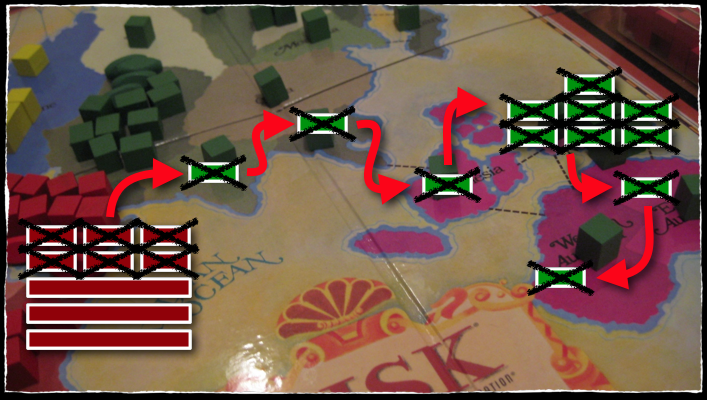 For this year's two-week summer enrichment games camp I turned once again to RISK as a reliable, clear, and rapid paced "tent pole" game around which to build our tournament.
For this year's two-week summer enrichment games camp I turned once again to RISK as a reliable, clear, and rapid paced "tent pole" game around which to build our tournament.Rather than the traditional board, I used a board that I painted with a custom map to match my Olde School Wizardry RPG campaign world. Major events and upsets during the tournament could then be used to shape events in my bi-monthly table top role-playing campaign.
I made some rules modifications to this old classic to make it serve our purposes.
- turn limit -- the game is played for 12 turns. The nation in control of the most territories at the end of the game wins.
- abandon territories -- players are not required to leave armies behind either when on the attack or when fortifying. However, abandoned territories are not considered "under control" when determining continent bonuses at the start of the turn.
- rivers -- major rivers can only be crossed at the marked bridges / fords or via ports.
- bridges -- in addition to allowing unhindered troop movement across rivers, intervening bridges also block movement from one port to another. Bridges can be destroyed or replaced at a cost of three armies provided that the player controls the territories on either side.
- ports -- all territories marked with ports are considered adjacent unless the route between them is blocked by a bridge. If both sides of the bridge are held by friendly troops (or another nation who agrees to "let the attack pass") the restriction on port-to-port movement is ignored for that turn.
- walled cities -- marked on the map, walled cities allow defenders to re-roll one die per attack if they so wish
- mountains -- impassable except where otherwise marked
 |
| Anyone who has ever played RISK knows about "Fortress Australia" |
The ports result in a much more interconnected map.
Compare North America's 3 points of entry in classic RISK game, or Australia's much-remarked single point of entry via Siam with the 17 possible places that Walvia (blue) can be assailed from.
This encourages a defensive game and with the addition of stronger defense via the walled cities it means that attacks have to be very large and very deliberate to have hopes of breaking through fortified lines. The result gives things more if a WWI flavor than a Napoleonic one, and it shifts the recipe for success away from mere dice rolling and to the unrestricted social game.
Players schemed, made deals, and broke bargains in a way that was completely unrestricted by the rules, and it was fun to watch as the action spilled over outside of class time as alliances of convenience were forged in the lunchroom.
I don't know if I'll use the same board for next year's summer games camp or hatch something new, but I'll definitely maintain the practice of having a "main event" game that lends context and continuity to the tournament.


No comments:
Post a Comment